Metaphors in the Tweets
Is the pen really mightier than the sword? In their provocative 1980 book, Metaphors We Live By, authors George Lakoff and Mark Johnson argue that metaphors are more than just rhetorical devices; they shape the very way we interpret and understand the world. “Metaphor is pervasive in everyday life,” they contend, “not just in language but in thought and action.”1 They lay out a compelling case, suggesting metaphors organize how we frame issues because they stir gut feelings, connecting to our past experiences and semi-conscious beliefs. Just like equating the pen and sword, which paints a mental picture likening these two instruments as weapons of power and influence, metaphors forge mental connections between different concepts and ideas. Once you start thinking about the metaphors omnipresent in language, it’s hard to escape their pervasive influence. While our purpose here is not to conduct a thorough discourse analysis of the complex chains and levels of metaphor and metonymy found in the tweets, the core idea of the ubiquitous nature of metaphors and their influence on perspectives motivates our investigation of the metaphors present in the tweets from the #commoncore network.
The metaphorical language chosen by tweeters evokes certain images and underlying paradigms. Furthermore, the medium of Twitter itself is unique, as it forces adherents to pack messages into 140 characters, spaces included. Because of this, people use far more staccato language, a lot of shorthand references, other hashtags that allow the same message to travel along multiple threads, mentions to particular others (using @name), and links to other web-based content, including blogs, news articles, and videos. While some decry the parsimony of Twitter as a shackling of expression, we also found the range of style strikingly rich. Brevity, at times, can be the soul of wit.
The tweets we analyze for metaphorical content are predominantly from the coded subsample of the dataset. As themes arose, we did additional searching of the entire dataset to see if these were persistent themes or more isolated cases. From these analyses, we noted at least six themes in which a range of #commoncore tweeters used similar metaphors to tie opposition to the Common Core to other hot-button cultural/ideological issues. These included:
- The Common Core as a Threat to American Values
- The Common Core as an Experiment on our Children
- The Common Core as a Source of Physical Harm to Children
- The Common Core as a Source of Psychological Harm to Children
- The Common Core as a Threat to Freedom
- The Common Core as a Threat to Future Generations
While we did not conduct our analyses by faction (green, blue, yellow) it is interesting to note that virtually all of these evocative connections came from views opposing the Common Core. This may be related to the fact that Common Core advocates tended to use more analytic policyspeak while opponents used the more visceral politicalspeak
The Common Core as a Threat to American Values
One theme used by opponents of the Common Core in their #commoncore tweets was to connect the Common Core reform to a degradation of American values. The notion that education reforms carry with them the values of their proponents in an old one, and has been manifested in debates about numerous reforms from those of the progressive era of the early 20th century to the “math wars” of the 1990s.2 Virtually all policy choices can be seen as a tradeoff between different underlying priorities and value systems, and any decision or activity can be interpreted as a prioritization of one value system over another. Because education is often charged with developing the ways future citizens think, it is a particularly high-stakes arena. The very idea of local control of education is rooted in the notion that curricular choices should reflect local values and not be forced from a distant government. This argument hearkens back to the very roots of America.
The metaphor of the Common Core as a vessel for the transmission of an (unwanted) value system is exemplified in the tweets below. They associate the Common Core with a set of values of undesirable others (socialists, ideologues, progressives, liberals). These bogeyman opponents are also catchwords that may catalyze certain oppositional groups, which is a key part of the argument for the power of metaphors. Further, some imply that this is being done surreptitiously or by sleight of hand, as most effectively stated in the tweet by @seanloughry.
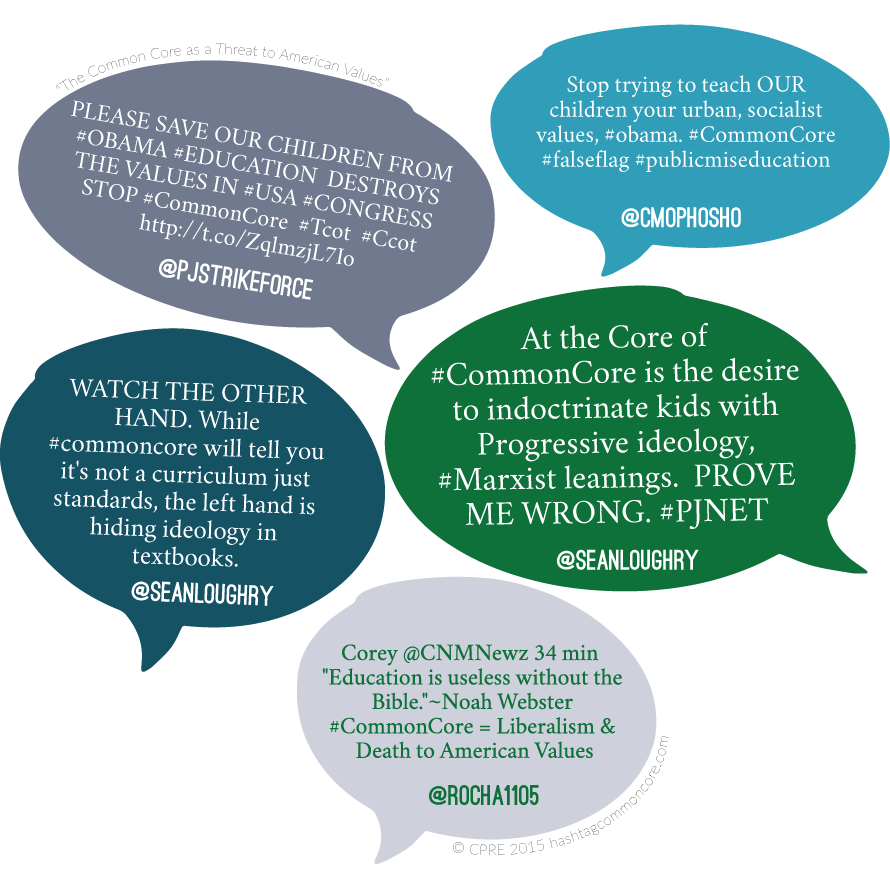
The Common Core as an Experiment on our Children
A frequent charge against undesired education initiatives is that there is no evidence to support their use and that implementing them without such evidence is akin to conducting an experiment upon our children. Unfortunately, very few educational practices pass this litmus test, and therefore virtually all prevailing educational approaches are in use without rigorous evidence of their efficacy. There are, in fact, recent movements in education to move more toward the medical model of applying randomized controlled trials to educational interventions before their widespread use. However, many large-scale social policy initiatives such as standards-based reform are simply not amenable to such random assignment methods, as it would raise serious questions on how states would be selected. Would we randomly assign the Common Core to States? What states would allow themselves to adopt or not based on a coin flip? Despite such impracticalities, the language of using children for experimentation of education initiatives often evokes fear and loathing.
The tweets below decry the Common Core as an experiment on our children. They connect the Common Core to various kinds of experimentation, including animal testing (i.e. guinea pigs), and medical testing. The example from @CarolinaCates explicitly makes the connection between testing the effectiveness of drugs and Common Core implementation, by equating “BigPharma” and “BigEd.” In this tweet and the two from @gamesmarcher and @coughlan4senate (a New Yorker running for state senate) the “Big Government” (i.e. federal government) is the perpetrator of experiments on kids.
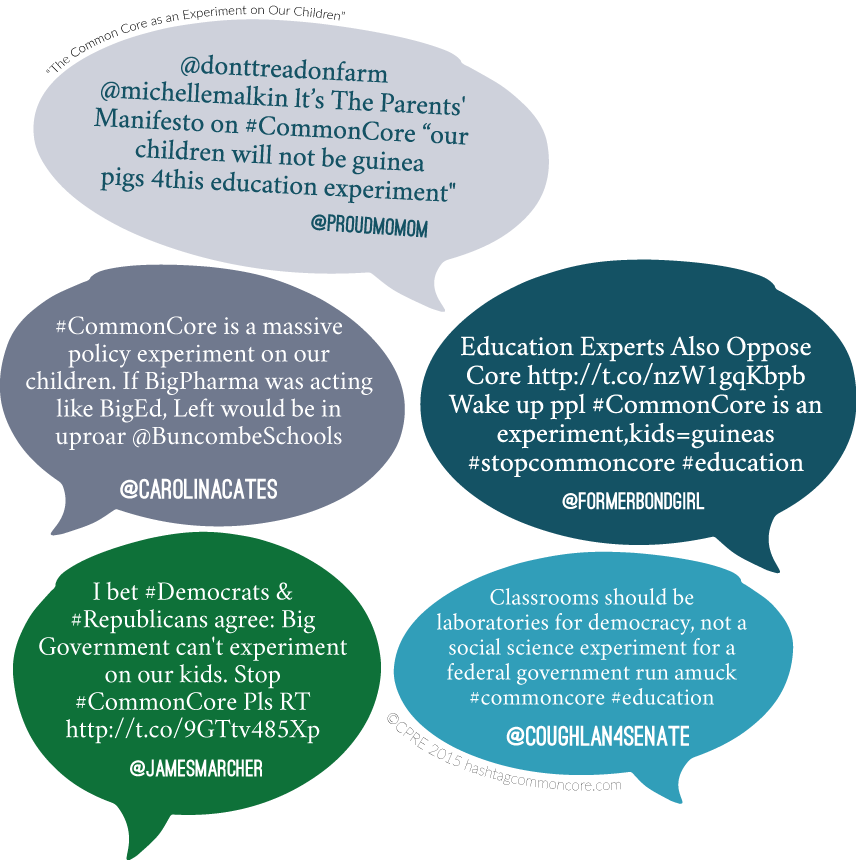
The Common Core as a Source of Physical Harm to Children
Another pervasive metaphor in the #commoncore tweets was the Common Core as a cause of physical harm to children. This was often associated with testing, but sometimes directly connected with the Common Core. The language of these tweets referred to horrible maladies such as vomiting, headaches, heart palpitations, and self-mutilation, then posited that these afflictions were directly caused by the Standards (by using words like ‘makes’, ‘causes’, and ‘results in’). Of course, the connection between a set of expectations on paper and these physical ailments is mediated by a wide variety of things, most notably the structures of education that link the Standards with pressure to achieve them, but these intermediary components are backgrounded to make the connection seem direct and imminent.
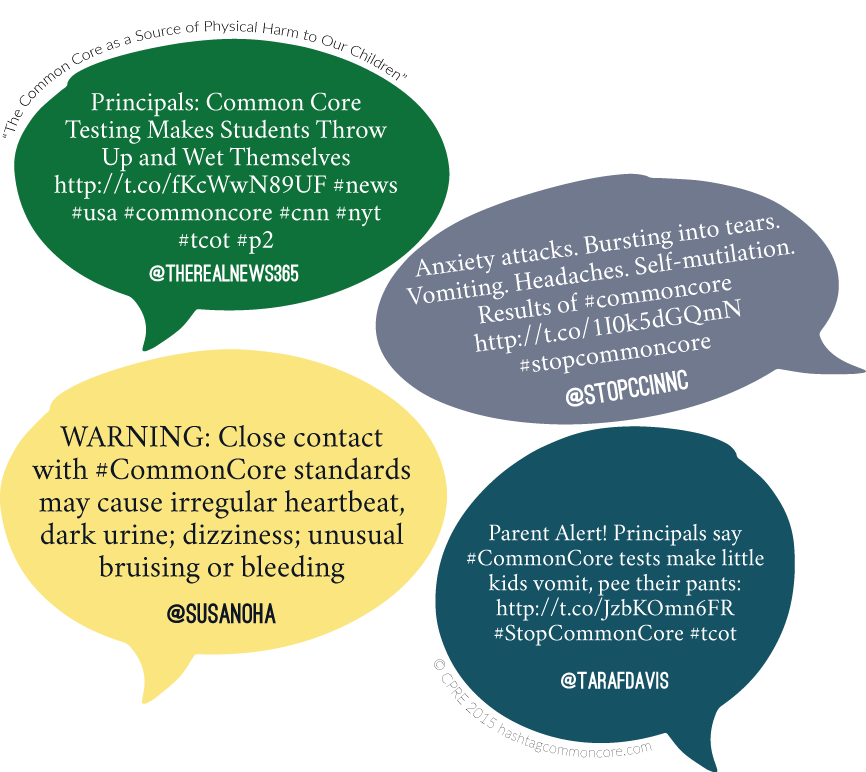
The Common Core as a Source of Psychological Harm to Children
While physical harm is threatening, perhaps even more menacing is the specter of psychological damage. There was a strain of #commoncore tweets that used language implying psychological threats to evoke the dangers of the Common Core to children. As the tweets below demonstrate, tweeters used such horrifically evocative terms as “mental child abuse,” “parental neglect,” “ruining kids’ minds,” and “brainwashing” to draw a connection between the Common Core and mental impairment. In doing so, this category of tweets sought to make explicit the connection between children’s intellectual and psychological development. The language tacitly reminds us that education initiatives that structure student learning can also convey messages influencing children’s developing belief systems (i.e. brainwashing).
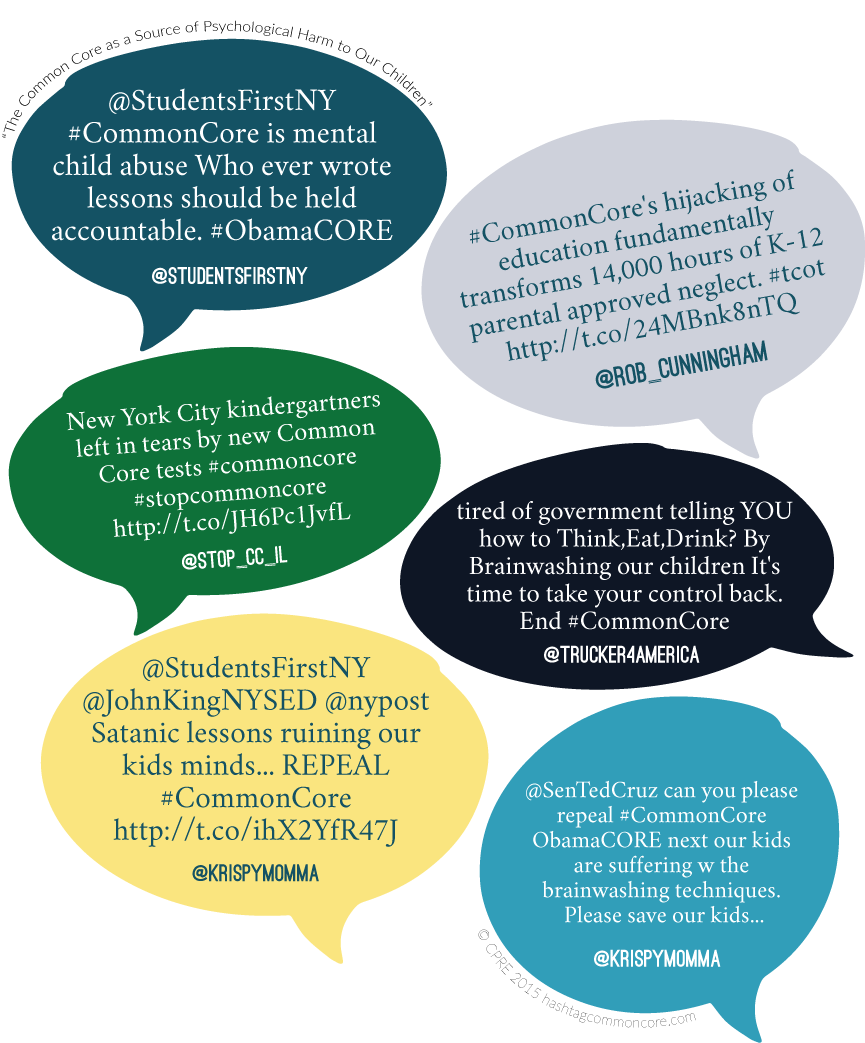
The Common Core as a Threat to Freedom
A number of authors used language that connected the adoption of the Common Core to a loss of freedom or, more insidiously, to a loss of freedom via an increase of governmental control. Thus, the tweet by @gerfingerpoken connects the Common Core to obedience and blind acceptance of authority. The tweet is cleverly constructed to incorporate references to both curriculum and instruction. These are both points of contention, as Common Core supporters adamantly claim the standards are not a curriculum nor do they advocate an instructional approach, while opponents say these things are inseparable from standards. The tweet also links to an article about subliminal messages in the choice of Common Core texts.
Both @NealMcCluskey and @occupycorruptDC connect the Common Core to a loss of freedom via governmental control. The @occupycorruptDC tweet adroitly bundles the Common Core with a variety of large-scale centralized government initiatives, including the Affordable Care Act (ObamaCare) and the National Defense Authorization Act (NDAA). This reinforces the perception of the Common Core as a federal initiative. In the short phrase “BIG BROTHER'S EDUCATION CORE,” @NealMcCluskey links the Common Core to George Orwell’s apocryphal novel, 1984, about the horrors of totalitarian governmental rule. Using similarly potent language, the final two tweets in this vein connect the Common Core to the indoctrination of children and warn parents to “wake up!”
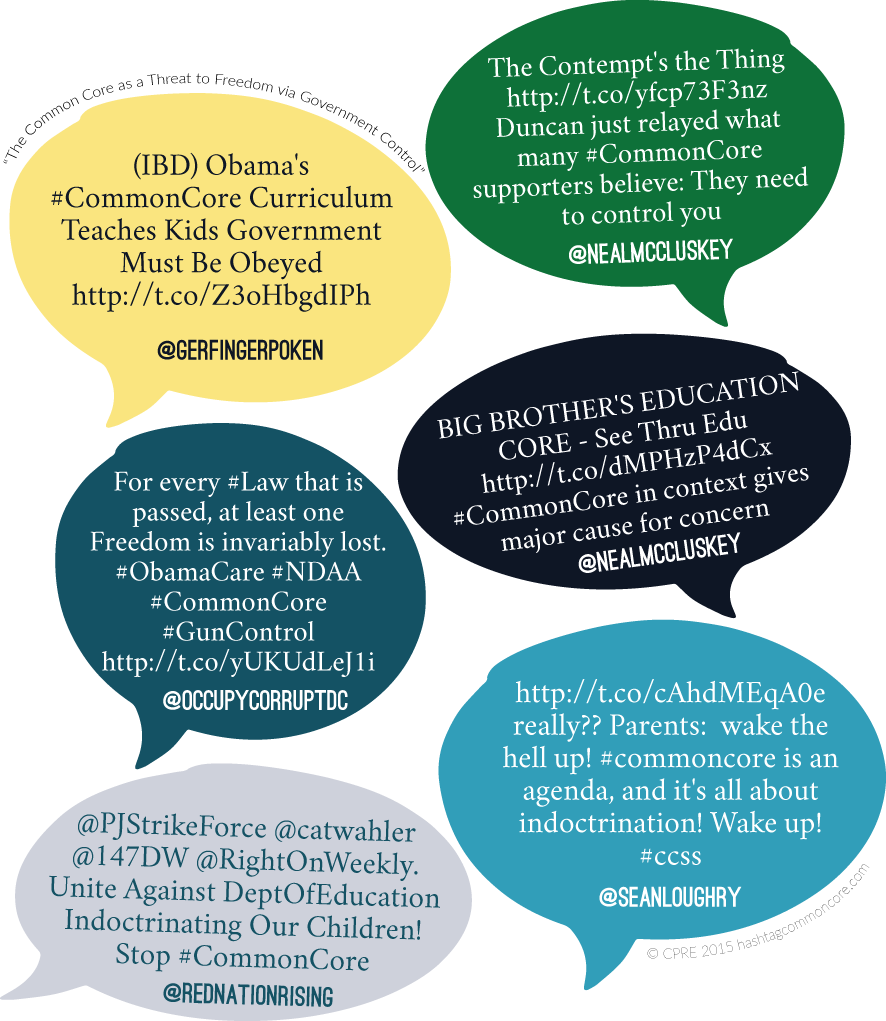
The Common Core as a Threat to Future Generations
In the final set of tweets, we see can see how the Common Core is sometimes depicted as a threat to future generations of children. These tweets play off the idea that children are young and therefore susceptible to the messages inserted into the Common Core. They combine both the notion that the Common Core is being knowingly used as a transmitter of an unwanted ideology and that children are vulnerable to the power of these messages.
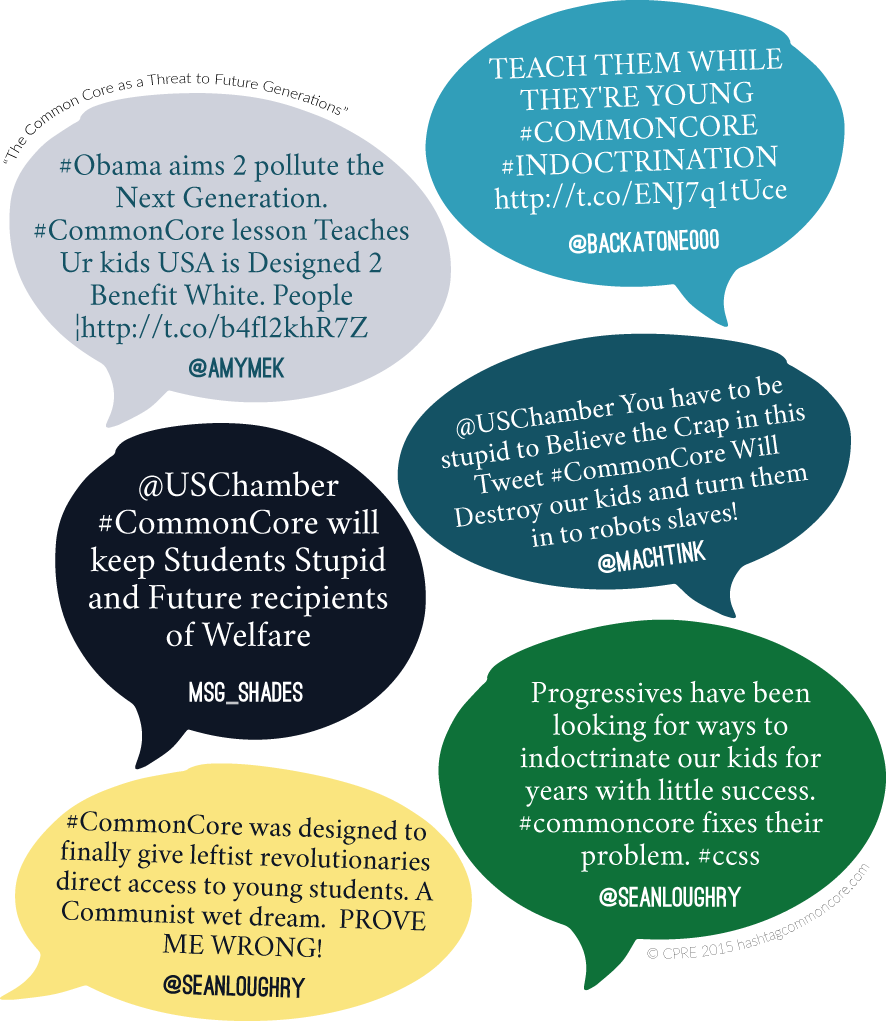
In sum, metaphors are powerful exactly because they have the ability to bring some aspects of a debate into sharper focus, but they also push other elements into the shadows. However, the power of these metaphors can also be dangerous because they can enmesh their creators in a web of words and image they themselves have spun, and in doing so obscure other realities. While highlighting insights and patterns, metaphors left unquestioned can become distortions that ensnare us.
So what do we make of the cumulative effect of all these negative conceptions of the Common Core? What is the overarching metaphor that comes from these six powerful themes? Is the Common Core really a giant all powerful brain-sucking monster that will corrode the minds and wrack the bodies of our youth, while scheming to strip away the freedom and liberty of adults? Or are the Common Core just a set of poor misunderstood standards, innocent as a little lamb, encircled by the sharp-teethed political wolves? While they may have started as mere rhetorical devices, metaphors like these and others that are woven throughout the fabric of #commoncore are powerful exactly because, if we repeat and retweet them enough, we become a captive within the logic established by the metaphor.
References
- Lakoff, G., & Johnson, M. (2008). Metaphors we live by. Chicago: University of Chicago Press.
- Schoenfeld, A. H. (2004). The math wars. Educational Policy, 18(1), 253-286.


